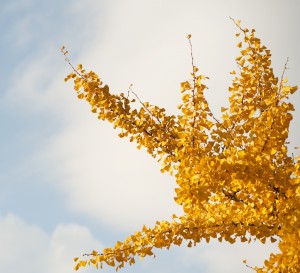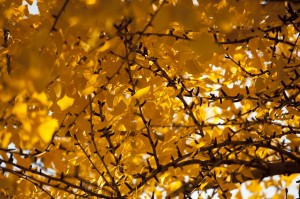A Living Fossil in New York
Posted in Around the Garden on December 3 2011, by Matt Newman
 The peak of fall foliage is an explosion of color, but the window of opportunity to catch this sort of beauty is sometimes slim. For some trees it only takes a week or two before the brilliant reds, oranges, and yellows that come with cooler weather have passed; you venture out one day to find every last leaf crunching underfoot, and a latticework of barren branches netting the sky above.
The peak of fall foliage is an explosion of color, but the window of opportunity to catch this sort of beauty is sometimes slim. For some trees it only takes a week or two before the brilliant reds, oranges, and yellows that come with cooler weather have passed; you venture out one day to find every last leaf crunching underfoot, and a latticework of barren branches netting the sky above.
As I walked through the Garden recently, noting the trees which were heavy with leaves just a week or two ago, I found myself hunting out the stragglers. I suppose it’s more accurate to call them survivors–the last of the foliated plants, big and small, still stubbornly holding onto their leaves when many growing around them have already closed up shop for the coming winter. Somehow, the few holding out until the last minute seem that much brighter for their small numbers.

One such gem is the maidenhair tree, more commonly known as Ginkgo biloba. An example of the ‘Lakeview’ cultivar stretches its wandering branches every which way just before the entrance to the Everett Children’s Adventure Garden. Its fan-shaped leaves sport a yellow hue right now that makes the tree one of the most eye-catching in the Garden. Of course, it’s probably all too familiar to anyone who’s spent time wandering city sidewalks.
In fact, 10% of all trees in Manhattan alone are ginkgoes, planted along residential streets for their shade, their resistance to insects and disease, and the fact that they can stand just about anything an urban environment can throw at them. Cold weather is a cakewalk, as is pollution or poor soil–some ginkgoes have even proven themselves sturdy enough to survive atomic blasts. (Yes, you read that correctly.) They’ve been cultivated in developed areas of China (their place of origin through recent history) for so many centuries that many experts believe the wild-grown Ginkgo biloba is a thing of the past; they’re pure-bred city dwellers nowadays.
Not that it’s all pretty colors and pleasantry with the maidenhair, as many New Yorkers will quickly point out. If you’ve ever enjoyed the fall weather around Central Park in October, you may already know what I’m talking about. Being what horticulturists like to call a ‘living fossil’ (it has few relatives in the plant world, and has been found as far as 70 million years back in the fossil record), the ginkgo is uncommon in that it comes in both male and female genders. And in 1895, when ginkgoes were becoming popular around the United States, the first superintendent of the United States Botanic Garden put the female’s problem in writing:
“The ginkgo, or maidenhair tree, is one of the very best; is first class. The only objection is the bad odor the fruit has when matured. My first handling of it cost me three hours’ time and a bar of soap to be rid of it.”
– William R. Smith
What the fallen seeds of the female ginkgo smell like is a point of contention, something to be left up to how creative you can be with your language–most of the comparisons are too unpleasant to mention here. However, “rancid dairy products” is a popular one. Each seed is covered in a fleshy shell that contains butyric acid–the cause of the problem. And every fall, angry residents strike up a chorus of calls to have the ginkgoes removed from the boroughs. But while the city’s Parks Department isn’t about to go around ripping up perfectly healthy, beautiful trees because of this slight and rather comical inconvenience, they’ve promised not to plant anymore female ginkgoes. DNA testing has made it much simpler to know what’s being put in the ground.

Lucky for our visitors, The New York Botanical Garden is quick to sweep up after our female ginkgoes before they can cause trouble, counting out that pesky problem of having to wear a clothespin on your nose just to enjoy the trees. And considering how stunning the leaves are around this time of year, we’re glad to have them about. I’m sure you’ll be just as happy to see these elegant yellow fossils if you stop by for a visit.
Have a favorite fall tree? Maybe you’re a fan of seeing the leaves, or perhaps you’d much rather catch the scent of pines in the winter. Either way, let us know.


this is a very interesting post, having loved this leaf for years, I now learned an extensive amount….thanks